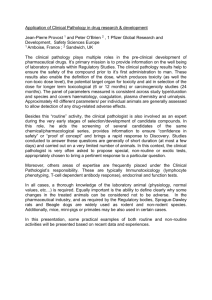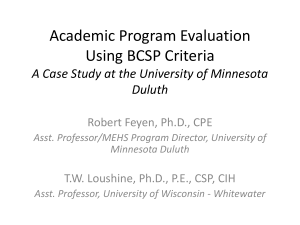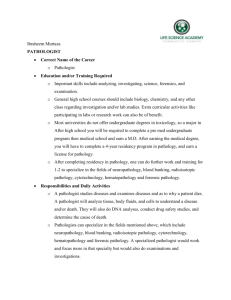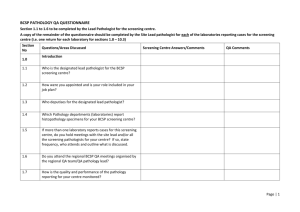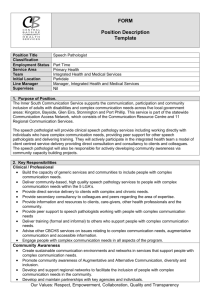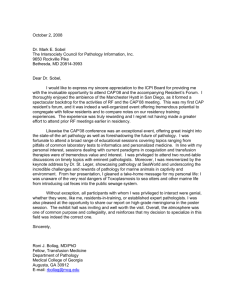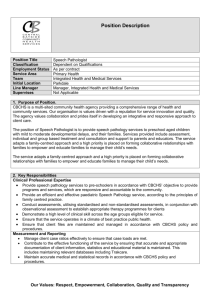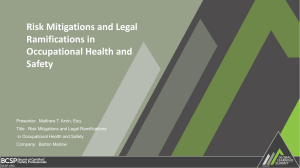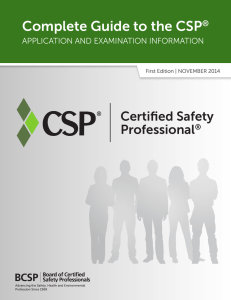A6 - Virtual Pathology at the University of Leeds
advertisement
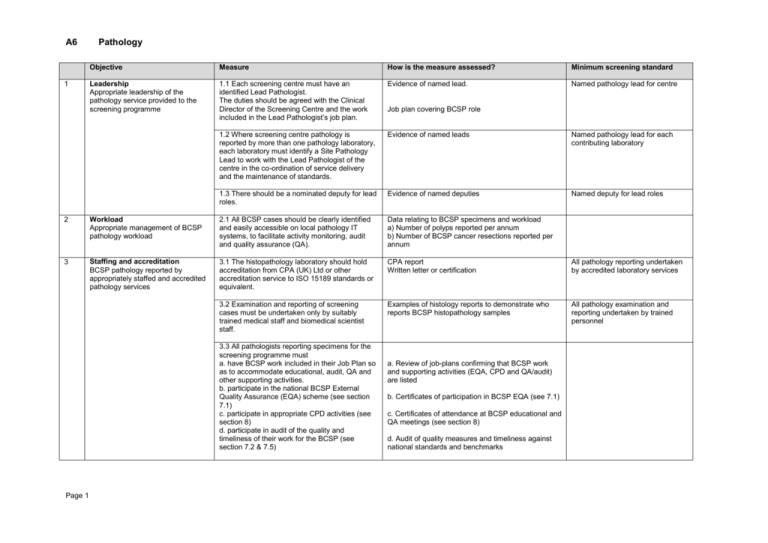
A6 1 Pathology Objective Measure How is the measure assessed? Minimum screening standard Leadership Appropriate leadership of the pathology service provided to the screening programme 1.1 Each screening centre must have an identified Lead Pathologist. The duties should be agreed with the Clinical Director of the Screening Centre and the work included in the Lead Pathologist’s job plan. Evidence of named lead. Named pathology lead for centre 1.2 Where screening centre pathology is reported by more than one pathology laboratory, each laboratory must identify a Site Pathology Lead to work with the Lead Pathologist of the centre in the co-ordination of service delivery and the maintenance of standards. Evidence of named leads Named pathology lead for each contributing laboratory 1.3 There should be a nominated deputy for lead roles. Evidence of named deputies Named deputy for lead roles Job plan covering BCSP role 2 Workload Appropriate management of BCSP pathology workload 2.1 All BCSP cases should be clearly identified and easily accessible on local pathology IT systems, to facilitate activity monitoring, audit and quality assurance (QA). Data relating to BCSP specimens and workload a) Number of polyps reported per annum b) Number of BCSP cancer resections reported per annum 3 Staffing and accreditation BCSP pathology reported by appropriately staffed and accredited pathology services 3.1 The histopathology laboratory should hold accreditation from CPA (UK) Ltd or other accreditation service to ISO 15189 standards or equivalent. CPA report Written letter or certification All pathology reporting undertaken by accredited laboratory services 3.2 Examination and reporting of screening cases must be undertaken only by suitably trained medical staff and biomedical scientist staff. Examples of histology reports to demonstrate who reports BCSP histopathology samples All pathology examination and reporting undertaken by trained personnel 3.3 All pathologists reporting specimens for the screening programme must a. have BCSP work included in their Job Plan so as to accommodate educational, audit, QA and other supporting activities. b. participate in the national BCSP External Quality Assurance (EQA) scheme (see section 7.1) c. participate in appropriate CPD activities (see section 8) d. participate in audit of the quality and timeliness of their work for the BCSP (see section 7.2 & 7.5) Page 1 a. Review of job-plans confirming that BCSP work and supporting activities (EQA, CPD and QA/audit) are listed b. Certificates of participation in BCSP EQA (see 7.1) c. Certificates of attendance at BCSP educational and QA meetings (see section 8) d. Audit of quality measures and timeliness against national standards and benchmarks 4 5 Page 2 Objective Measure How is the measure assessed? Minimum screening standard Laboratory processes, including risk management Laboratory processes provide safe and high quality pathology reporting 4.1 Histopathology reporting must be in accordance with RCPath/BCSP guidance relating to the specimen type being reported Review of standard operating procedures (SOPs) and reports, including processes for receipt, dissection and measurement Compliance with RCPath/BCSP pathology guidelines 4.2 Histopathology reports for at least 90% of specimens submitted from endoscopy should be authorised and relayed to referrer within 5 working days of receipt of the specimen in the laboratory. Results of turn around time audit 90% of reports of BCSP specimens available within 5 working days 4.3. Each centre must establish a protocol for the referral for specialist opinion when there is uncertainty over a histological diagnosis. Opinions may be obtained from a. A second local pathologist b. A regional specialist gastro-intestinal pathologist or reference panel c. The ‘Expert Board’, established and funded by BCSP, especially for difficult polyps. Local protocol or SOP for dealing with difficult cases Local protocol for dealing with difficult cases 4.4 Newly appointed screening pathologists (or those returning after prolonged periods of absence) must be inducted and mentored by the site lead pathologist to ensure that they are properly acquainted with the local BCSP processes, and that there is compliance with national guidelines and local operational procedures. The site lead should confirm this to the Clinical Director of the Screening Centre. Letter to Screening Centre Clinical Director confirming induction of new reporting pathologists Induction of all new BCSP pathologists 4.5 All pT1 polyp cancers must be “double reported” i.e. reviewed and the diagnosis agreed by at least two screening pathologists. The issued report should contain a statement to this effect. Review of pT1 cancer reports 100% of pT1 polyp cancers doublereported 4.6 Laboratories should agree a procedure with the Screening Centre for the management of cases where there is a change of diagnosis. SOP for the management of cases where there is a change of diagnosis. 5.1 All cancer cases generated by the BCSP must be discussed in a colorectal cancer multidisciplinary team meeting (MDTM) to plan future management. Minutes or records of MDT meetings 5.2 Reports of unexpected cancers diagnosed by histopathology without prior indication must be conveyed to the Specialist Screening Practitioner within 24 hours of confirmation of histology so that appropriate patient counselling and investigations can be instituted Confirmation from SSPs and/or local SOP 5. Communication Good communication between pathologists, screening centre personnel and colorectal cancer multidisciplinary teams All cancer cases discussed in a colorectal cancer MDTM Objective 6. 7 8. Page 3 Data collection Pathology reporting processes facilitate accurate data collection and quality monitoring QA and audit Participation in audit and QA processes leading to service improvement Training and CPD BCSP pathology is reported by appropriately trained staff who participate in relevant CPD and maintain skills Measure How is the measure assessed? Minimum screening standard 5.3 There should be good levels of communication between the screening centre staff, including the Lead Pathologist of the centre Minutes of screening centre operational and governance/QA meetings 6.1 Histopathology for the BCSP should contain all relevant information in an easily retrievable form, for example by the use of standardised proformas or template reports Review of reports and proformas Use of standardised proforma or template 6.2 Histopathology reports generated freehand or by cancer dataset software should include all key items of the relevant RCPath/BCSP dataset for polyps, polyp cancers, cancer local excisions and cancer resections Review of reports and proformas Proformas or reports contain all relevant dataset items 7.1 The Lead Pathologist for the screening centre should ensure that all pathologists reporting specimens for the screening programme participate in the national BCSP EQA scheme List of pathologists confirming registration and participation in the National BCSP Histopathology EQA Scheme All reporting pathologists participate in the national BCSP EQA scheme 7.2 The Lead Pathologist for each centre should audit the pathology quality indicators against the screening programme benchmarks List of relevant audits since previous visit detailing procedure, results and actions 7.3 The Lead Pathologist for each centre and the Site Leads should participate in and comply with the QA processes established by the relevant regional BCSP Quality Assurance team List of regional QA activities (e.g. meetings and visits), confirming participation 7.4 The laboratory should demonstrate overall satisfactory performance in an accredited technical quality assessment scheme (TQAS) EQA list showing schemes participated in and summary results 7.5 Regular audit and review should be undertaken in each laboratory, to include the discussion of interesting and problem cases Evidence of relevant audit/discussion meetings 8.1 All pathologists involved in reporting of BCSP cases must participate in regular training and QA activities provided by or recognised by the screening programme. (It is recommended that individuals attend regional or national education and QA meetings at least twice in each three year QA cycle) Certificates of participation in BCSP approved training, educational and QA meetings (see 3.3 and 7.3) Certificates of participation in BCSP EQA (see 3.3.b) Attendance at two relevant regional or national educational or QA meeting in any three year QA cycle 9. Objective Measure How is the measure assessed? Quality markers and data quality assessment Quality markers and pathology data are reviewed and benchmarked to guarantee the quality of the service provided 9.1 The pathology data for each centre should be bench-marked against national data and the quality standards recommended within the relevant RCPath/BCSP guidance on the reporting of screening pathology and colorectal cancers. Review of data for centre and individual laboratories including proportion of adenomas as a proportion of total BCSP polyp numbers proportion of low grade dysplasia versus high grade dysplasia for BCSP adenomatous polyps proportion of each type of serrated lesion in BCSP polyps Quality markers of cancer resection data as per RCPath colorectal cancer guidelines and datasets for each BCSP pathologist (last 50 sequential cases) Median number of lymph nodes harvested Rates of serosal involvement for colonic and rectal cancer (separately) Rate of extramural venous spread for colorectal cancer Stage distribution of colorectal cancers itemised for Dukes and TNM stage (last 100 sequential cases) BCSP Pathology QA Standards (2013 review) Page 4 Minimum screening standard Median node yield: > or = 12 Serosal involvement: Colon > or = 20% Rectum > or = 10% Extramural venous spread: > or = 25%



